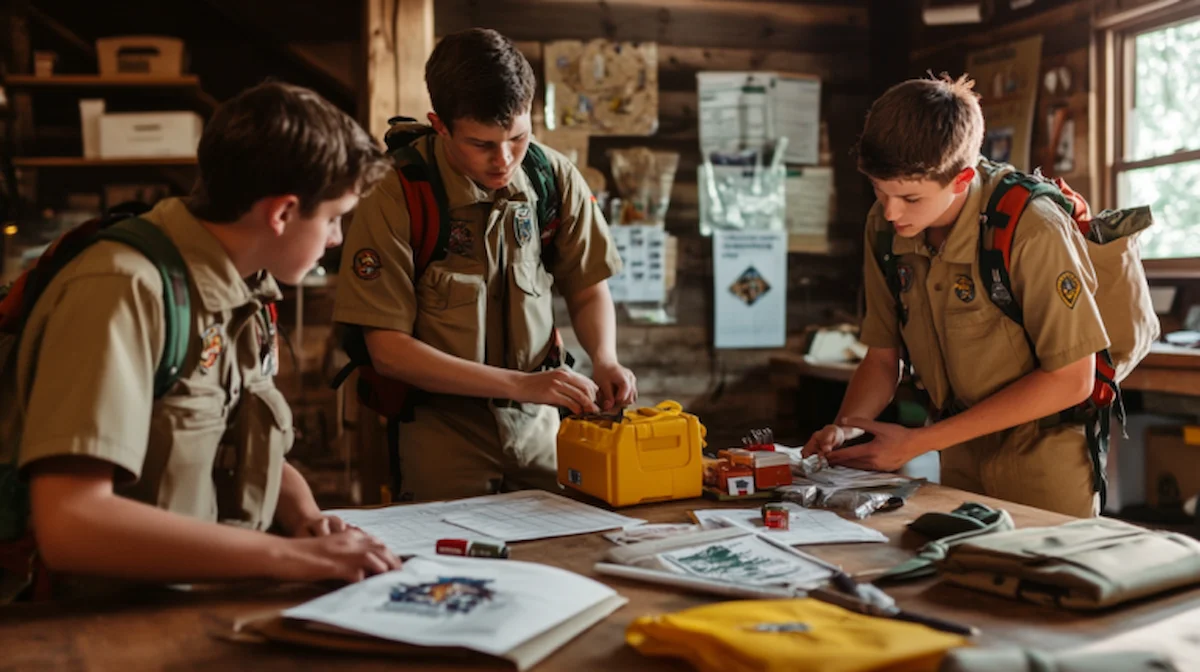Earning the emergency preparedness merit badge packet is more than just a step toward Eagle Scout—it’s a critical life skill that teaches Scouts how to respond in times of crisis. Whether you’re preparing for natural disasters, practicing emergency drills, or assembling a disaster kit, the emergency preparedness merit badge packet gives you a structured path to learn, plan, and take action. This guide will walk you through how to complete the packet successfully, what materials you’ll need, and how to meet each requirement with confidence. If you’re a Scout, a parent, or a troop leader, understanding how to properly use the emergency preparedness merit badge packet is the key to making the most of this important learning experience.
How to Complete the Emergency Preparedness Merit Badge Packet Successfully
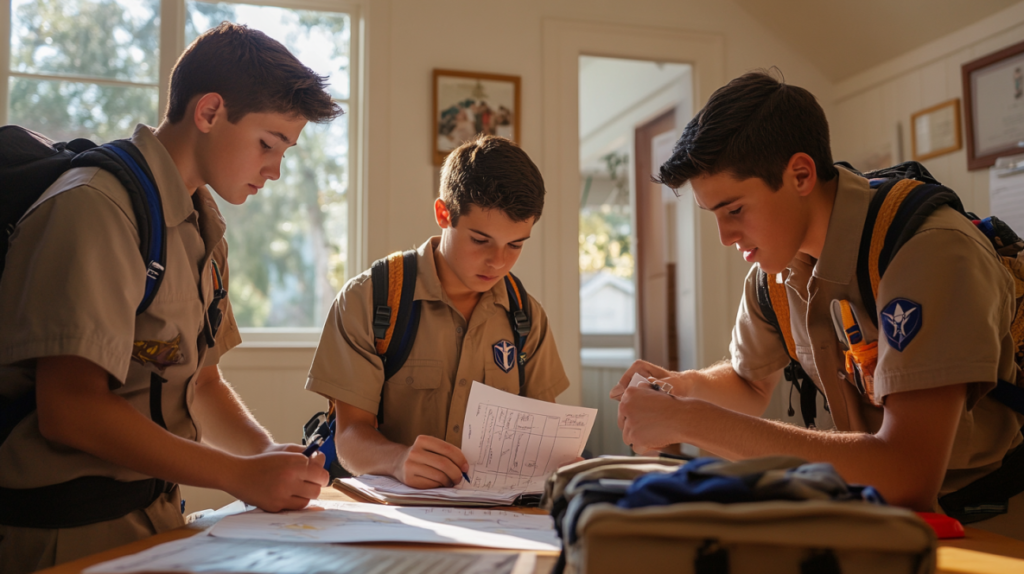
Completing the emergency preparedness merit badge packet successfully requires more than just filling in answers—it involves real planning, hands-on learning, and active participation. This merit badge is designed to prepare Scouts for real-world emergencies by guiding them through vital steps like creating a family emergency plan, building a disaster kit, and participating in drills. To make the most of the emergency preparedness merit badge packet, it’s important to approach each requirement with focus, clarity, and a sense of responsibility.
Here are the most important steps and ideas to follow as you complete your emergency preparedness merit badge packet:
1. Carefully Read Each Requirement in the Packet
- Before answering anything, read every section thoroughly.
- Understand exactly what the emergency preparedness merit badge packet is asking—many requirements involve action, not just written responses.
- Example: Requirement #1 asks you to list potential emergency situations. Take time to research scenarios like floods, earthquakes, fires, or power outages.
2. Build a Family Emergency Plan
- One key task in the packet is developing a plan that includes escape routes, meeting points, and contact information.
- Tip: Use printable templates or download planning guides from Scouting.org or FEMA to help organize your thoughts.
- Example: Include roles for each family member, such as who’s responsible for pets or first aid supplies.
3. Assemble an Emergency Supply Kit
- The emergency preparedness merit badge packet requires Scouts to create or demonstrate knowledge of a disaster supply kit.
- You can actually build one as a family project to make this step fun and interactive.
- Suggested items (or “toys” for learning):
- Flashlight & extra batteries
- First aid kit
- Bottled water & non-perishable snacks
- Emergency blanket
- Whistle, maps, phone charger
4. Participate in an Emergency Drill
- The packet often requires Scouts to take part in or lead a drill (like a fire evacuation or storm shelter exercise).
- Practice with your family, school, or Scout troop.
- Bonus tip: Document the drill with photos or notes to present to your merit badge counselor.
5. Work Closely with Your Merit Badge Counselor
- Your emergency preparedness merit badge packet must be reviewed and approved by a registered counselor.
- Keep your packet neat, thorough, and organized.
- Come prepared with your answers, supporting materials, and questions.
- Example: Bring a printout of your family emergency plan or a checklist of items in your emergency kit.
Completing the emergency preparedness merit badge packet successfully isn’t just about checking off boxes—it’s about learning how to stay calm and act effectively when it matters most. The more effort and thought you put into each part of the packet, the more prepared you’ll be to face real emergencies with confidence and leadership.
What’s Inside the Emergency Preparedness Merit Badge Packet?
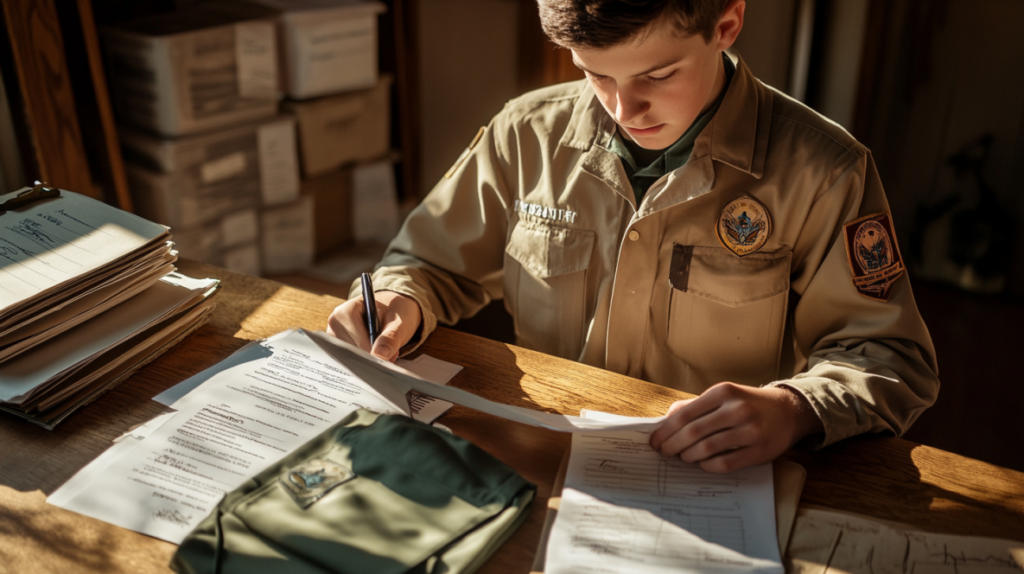
Before you can complete it, you need to understand what the emergency preparedness merit badge packet actually includes. This packet serves as the core roadmap for earning one of the most important badges in Scouting—it’s your guide, checklist, and workbook all in one. Knowing what’s inside the emergency preparedness merit badge packet helps Scouts, parents, and leaders stay organized and ensures no steps are missed during the process.
Below are the key components typically found in the emergency preparedness merit badge packet, along with examples and tools that can help:
1. Merit Badge Worksheet
- This is where you’ll write your answers and responses to each requirement.
- It includes spaces for writing emergency scenarios, emergency plans, and action steps.
- SEO Tip: Refer to this as the “emergency preparedness merit badge worksheet” in your internal linking.
- Example: Fill in a scenario like “house fire” and list steps your family would take to stay safe.
2. Full List of Requirements
- A breakdown of all the official merit badge requirements, often based on the Boy Scouts of America guidelines.
- You’ll find tasks like:
- Identifying potential emergencies
- Explaining first aid procedures
- Preparing an emergency supply kit
- Participating in emergency drills
- Tip: Highlight which requirements need hands-on activity versus written explanation.
3. Activity Checklists
- These are mini checklists or summaries to track your progress through the emergency preparedness merit badge packet.
- Great for organizing tasks like kit-building, family plan completion, or safety drills.
- “Toys” or tools to help:
- Printable checklists
- Dry-erase planning boards
- Badge tracking apps
4. Emergency Planning Templates
- Many packets include blank forms or templates for building a family emergency plan.
- These may ask for:
- Emergency contact numbers
- Exit routes from your home
- Designated meeting points
- Idea: Involve your family in filling these out to make it a shared learning experience.
5. Counselor & Scout Leader Instructions
- This section explains how to submit your completed packet and how your merit badge counselor will evaluate your work.
- It may include:
- Signature fields for verification
- Space to record dates of completed drills or troop discussions
- Tip: Keep this section tidy and double-check every requirement is signed off before submission.
Understanding what’s inside the emergency preparedness merit badge packet is the first step toward earning it successfully. With a clear grasp of each component, you’ll move forward with confidence—and complete the badge requirements the right way.
Step-by-Step Guide to Fulfilling the Merit Badge Requirements
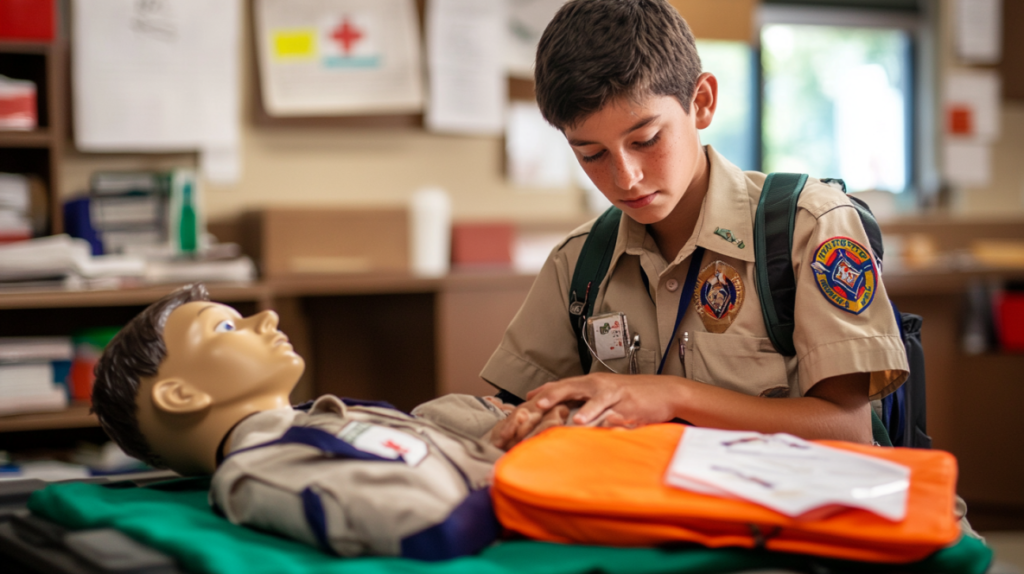
Once you understand what’s inside the emergency preparedness merit badge packet, the next step is to complete each requirement with care and accuracy. This badge isn’t just about theory—it’s about preparing for real-world emergencies through action, planning, and critical thinking. Each requirement in the emergency preparedness merit badge packet builds essential life skills, from creating an emergency plan to demonstrating first aid techniques.
In this section, we’ll walk you through how to fulfill the most important requirements step by step, with examples, ideas, and practical tools that can help you succeed.
1. Identify and Discuss Potential Emergencies (Requirement 1)
- List various emergency scenarios that could affect your community or home.
- Examples include earthquakes, wildfires, house fires, floods, and power outages.
- Tips:
- Use online resources like Ready.gov to research real threats in your area.
- Discuss how to prepare for and respond to each scenario.
- SEO Note: This supports the keyword emergency preparedness merit badge packet by addressing its core objectives.
2. Create a Family Emergency Plan (Requirement 2)
- Design a detailed plan covering evacuation routes, meeting points, contact lists, and communication strategies.
- Ideas to include:
- A map of your home with marked exits
- A checklist of who does what during an emergency
- A wallet card with emergency contacts
- Tools or “toys”:
- Printable family plan templates
- Magnetic emergency charts for refrigerators
- Flashcard games to teach emergency roles to younger siblings
3. Assemble an Emergency Supply Kit (Requirement 8)
- You must either build or describe a 72-hour emergency kit.
- Include essentials like:
- Bottled water
- First aid supplies
- Non-perishable food
- Flashlight, radio, batteries
- Extra clothing and blankets
- Pro tip: Build your kit as a family activity—it makes the learning more memorable and checks off part of your emergency preparedness merit badge packet at the same time.
4. Participate in or Conduct an Emergency Drill (Requirement 7)
- Join a school, community, or home-based emergency drill—or plan your own.
- Types of drills:
- Fire evacuation
- Earthquake safety simulation
- Tornado shelter-in-place practice
- Document the drill with photos, notes, or video to show your merit badge counselor.
- Bonus: Include a checklist of how you responded during the drill.
5. Explain First Aid for Emergency Situations (Requirement 6)
- You’ll need to explain or demonstrate basic first aid procedures for shock, bleeding, burns, broken bones, and other common injuries.
- Learning ideas:
- Watch trusted first aid videos from the American Red Cross
- Use a toy first aid kit to practice with your troop or family
- Create flashcards with symptoms and response actions
Completing the requirements in the emergency preparedness merit badge packet step-by-step ensures you’re not only meeting badge criteria—but also gaining the knowledge and confidence to act during real emergencies. Follow these steps with dedication, and you’ll be one step closer to being truly prepared.
Tips for Working with Your Merit Badge Counselor and Scout Leader
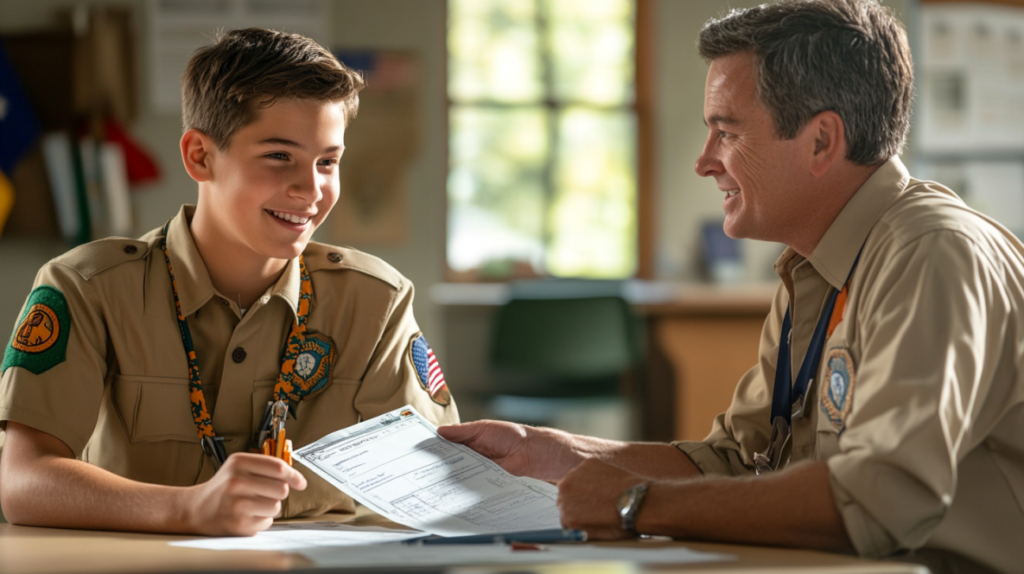
Successfully completing the emergency preparedness merit badge packet doesn’t happen in isolation—it requires close communication and collaboration with your merit badge counselor and Scout leader. These individuals are here to guide you, verify your work, and ensure that you understand and apply the skills you’re learning. Knowing how to work effectively with them not only helps you complete the emergency preparedness merit badge packet more efficiently but also builds leadership and accountability.
Below are key tips and practical tools to help Scouts get the most out of this mentorship process.
1. Keep Your Packet Neat and Organized
- A clean, legible, and complete emergency preparedness merit badge packet makes a strong impression.
- Use a folder to keep your packet, notes, and checklists in one place.
- Tip: Use color-coded sticky notes or tabs to mark sections you’re ready to review with your counselor.
2. Prepare Before Every Meeting
- Don’t show up empty-handed. Always bring your emergency preparedness merit badge packet, a pen, and any completed assignments.
- Ideas to bring:
- A printed family emergency plan
- A photo of your completed emergency kit
- Notes from your emergency drill participation
- “Toy” or tool: A Scout-branded notebook or binder to keep all materials in one place
3. Schedule Check-Ins for Specific Requirements
- Instead of trying to complete everything at once, plan a few short meetings to go over specific parts of the packet.
- This allows your counselor to give detailed feedback and helps you stay on track.
- Example: One session to discuss your emergency kit and another to review your family plan or first aid skills.
4. Ask Questions and Request Clarification
- Don’t guess—if you’re unsure about a requirement in the emergency preparedness merit badge packet, ask!
- Your counselor is there to help explain terminology, provide examples, and guide your understanding.
- SEO tip: Mentioning “merit badge counselor tips” supports LSI keyword relevance.
5. Provide Evidence of Your Work
- Use photos, charts, drawings, or digital checklists to document your progress.
- For example:
- Take pictures of your family emergency plan posted on the wall
- Record a short video showing your packed emergency supply kit
- Create a visual timeline of steps you took to complete the packet
- These help prove completion and add value to your final presentation.
Building a good working relationship with your counselor and Scout leader is just as important as the requirements in the emergency preparedness merit badge packet. When you’re prepared, organized, and proactive, you’ll find the process smoother, more rewarding, and a lot more enjoyable.
Real-Life Emergency Preparedness Activities for Scouts
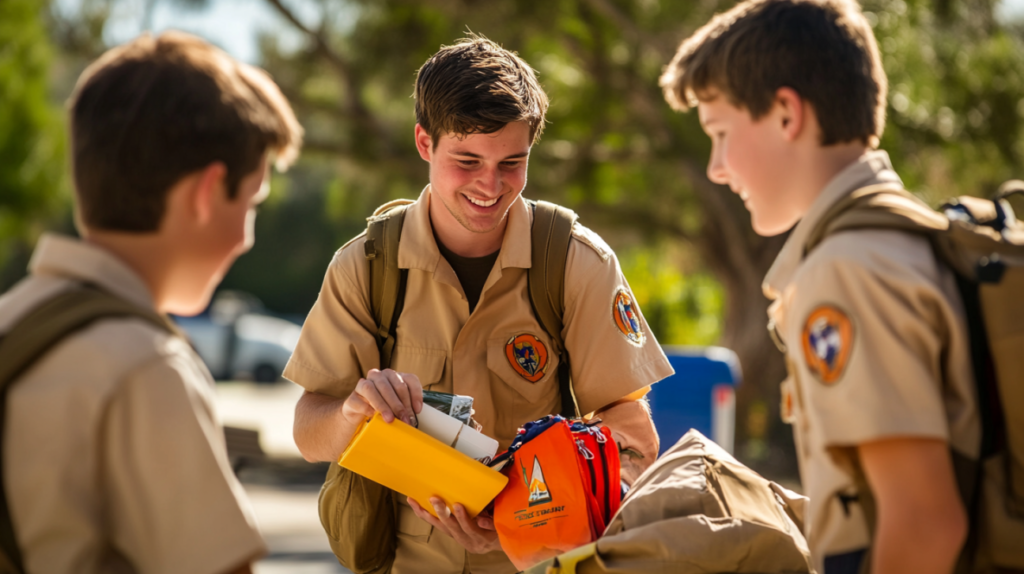
One of the most effective ways to master the emergency preparedness merit badge packet is by taking learning beyond the worksheet. Real-life activities allow Scouts to turn theory into action—helping them better understand how to respond during emergencies, think critically under pressure, and work as a team. These hands-on experiences also fulfill several requirements in the emergency preparedness merit badge packet and make the journey toward earning the badge more fun and meaningful.
Below are engaging, real-world activities and tools that Scouts can try with their families, troops, or communities.
1. Plan and Run a Family Emergency Drill
- Practice a realistic home evacuation drill for situations like fire or earthquake.
- Assign roles to each family member and time how long it takes to get to a safe meeting point.
- Tip: Use a stopwatch, and repeat monthly to improve response time.
- Tools or “toys”:
- Emergency whistle
- Home exit route floor plan
- Reflective vests or glow sticks
2. Build a DIY Emergency Supply Kit
- Put together a real 72-hour survival kit as outlined in the emergency preparedness merit badge packet.
- Involve younger siblings or troop members in a “kit scavenger hunt” to collect necessary items.
- Include:
- Flashlight, batteries, and radio
- First aid kit
- Food & water supplies
- Blankets, gloves, poncho
- Important documents in a waterproof pouch
3. Demonstrate First Aid Skills
- Practice first aid scenarios using real or toy supplies.
- Set up a mock situation (e.g., a fall or burn) and role-play how to respond using your first aid knowledge.
- Ideas to enhance the activity:
- Use bandages and slings for practice
- Watch instructional videos from trusted organizations like the American Red Cross
- Host a “First Aid Challenge” with your troop
4. Create a Community Emergency Plan Map
- Identify safe zones, shelters, hospitals, and fire stations in your area.
- Draw or digitally map these locations and build a contact sheet for emergency services.
- Bonus: Present your map during a troop meeting for review and feedback.
- Tools:
- Google My Maps for digital mapping
- Colored markers and poster board for printed maps
5. Visit or Volunteer at a Local Fire Department or CERT Event
- Arrange a field trip or interview with first responders to learn about emergency roles and responsibilities.
- Ask questions like:
- “What should families do in the first 5 minutes of a disaster?”
- “What’s one mistake people make during emergencies?”
- Real-world exposure adds depth to your work in the emergency preparedness merit badge packet and helps Scouts see how their training connects with the community.
Incorporating these real-life emergency preparedness activities into your Scout journey not only makes completing the emergency preparedness merit badge packet easier—it also prepares you to stay calm, lead others, and protect yourself and your loved ones when it matters most.
Common Mistakes to Avoid When Completing the Packet
Even the most enthusiastic Scouts can run into avoidable issues when working on the emergency preparedness merit badge packet. While the packet provides a clear roadmap, overlooking small details or rushing through sections can result in delays, confusion, or the need to redo important tasks. Knowing what to avoid can save time and help ensure your submission is accurate, complete, and approved by your merit badge counselor without extra revisions.
Here are the most common mistakes Scouts make with the emergency preparedness merit badge packet, along with tips, tools, and ideas to stay on the right path:
1. Skipping or Misreading Requirements
- Many Scouts accidentally skip parts of a requirement or misunderstand what’s being asked.
- For example, some may describe an emergency plan instead of actually creating one.
- Tip: Read each instruction slowly and highlight keywords like “demonstrate,” “create,” or “participate.”
- Tools to help:
- Highlighter pens or sticky notes
- A checklist app to track completed steps
2. Failing to Document Real-Life Activities
- If you participated in an emergency drill or built a kit, you must document it clearly.
- Common issue: Telling the counselor you did something without any proof.
- Ideas:
- Take photos of your emergency supply kit and family meeting point
- Write a brief journal entry after your emergency drill
- “Toy” idea: Use a mini photo album or scrapbook for visual presentation
3. Turning in a Disorganized or Incomplete Packet
- Counselors often reject packets that are messy, missing answers, or lack signatures.
- Tip: Review the entire emergency preparedness merit badge packet twice before submission.
- Tools:
- Binder with tabs for each requirement
- Final review checklist with sign-off boxes
4. Not Practicing First Aid or Emergency Skills
- Some Scouts try to complete first aid sections without actual practice.
- This not only weakens your understanding but also affects your performance in a real emergency.
- Ideas:
- Practice first aid with family members using a toy kit
- Host a skills demo night with your troop
- Watch and follow along with training videos from the American Red Cross
5. Waiting Until the Last Minute
- Rushing through the packet close to a badge deadline leads to poor-quality work and missing elements.
- Recommendation: Set weekly goals to complete 1–2 requirements at a time.
- Tools to avoid procrastination:
- Scout calendar or planner
- Reminder apps like Google Keep or Trello
Avoiding these common mistakes will not only help you complete the emergency preparedness merit badge packet faster, but it will also improve your confidence and understanding of emergency readiness. Be thoughtful, thorough, and proactive—and you’ll finish strong.
Conclusion
Completing the emergency preparedness merit badge packet is a meaningful milestone in every Scout’s journey. It’s not just a box to check—it’s a skill set that could save lives. From understanding emergency scenarios and building survival kits to planning drills and practicing first aid, each part of the emergency preparedness merit badge packet helps you become more prepared, more confident, and more capable of helping others in times of need.
As you’ve learned in this guide, success comes down to taking each step seriously, avoiding common mistakes, and working closely with your merit badge counselor and Scout leader. The emergency preparedness merit badge packet is designed to challenge and educate, but with the right mindset and preparation, you can complete it with pride and purpose.
Ready to get started? Download your packet, gather your tools, and take the first step toward earning a badge that truly matters.

